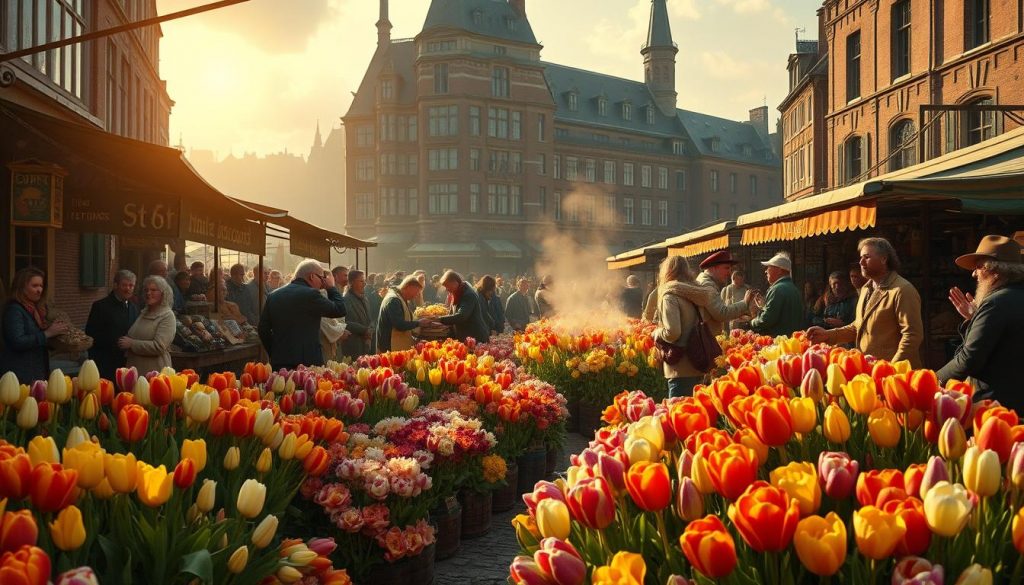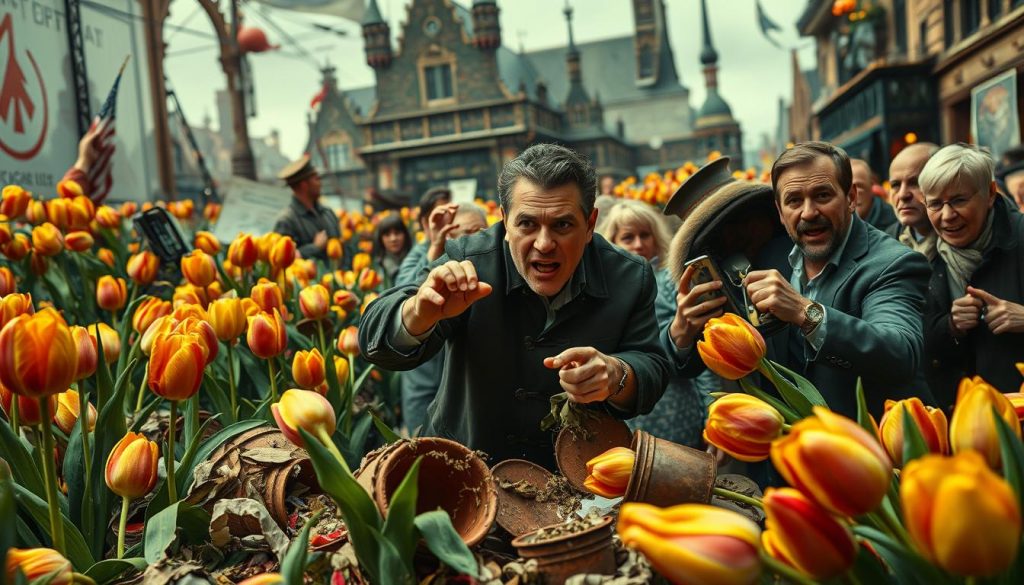The Tulip Mania in the Dutch Golden Age: The World’s First Financial Bubble.
In the Dutch Golden Age, a unique economic event called Tulip Mania took place. From 1634 to 1637, the Netherlands saw a financial bubble around tulip bulbs. This event has fascinated historians and economists for centuries.
Anúncios
The Tulip Mania is a key moment in economic history. Rare tulip bulbs were sold for prices that were six times the average salary. At its peak, some bulbs were worth as much as a mansion on Amsterdam’s Grand Canal.
Speculators from all over Holland joined the market, pushing prices up. A single tulip bulb could cost between 4,000 to 5,500 florins.
The most valuable bulbs were worth over 1 million USD today. This frenzy turned simple flower bulbs into big investments, showing the dangers of market madness.
This event is seen as the world’s first recorded financial bubble. It shows how fast markets can change, making ordinary things seem incredibly valuable.
Anúncios
The Tulip Mania is a deep dive into human psychology, economic speculation, and market volatility.
Origins of Tulips in the Dutch Republic
The story of tulips in Europe started in the 16th century. The Dutch Republic became the main place for growing them. These exotic flowers came from the Ottoman Empire, exciting botanists and merchants across Europe.
Important people helped tulips arrive in the Netherlands:
- Ogier de Busbecq, an Austrian diplomat, first brought tulip seeds from Constantinople
- Carolus Clusius, a famous botanist, started a new horticultural center at the University of Leiden in 1593
- The unique genetic variations of tulips made them very attractive to collectors
The Dutch Republic’s farming scene changed fast. Tulip growing turned into a big business.
“Tulips are not just flowers, but living artifacts of botanical wonder and economic potential.” – Anonymous Botanist
Here are some stats that show how big tulips were in Dutch farming:
| Agricultural Metric | Netherlands Statistics |
|---|---|
| Land used for agriculture/horticulture | 60% |
| Global flower bulb production | 77% |
| Global floricultural trade share | 44% |
These numbers show the Dutch Republic’s leading role in European horticulture. They set the stage for the tulip craze that would soon amaze the world.
The Rise of Tulip Trading in Holland
In the Dutch Golden Age, tulip trading grew from a simple hobby to a complex economic activity. The Netherlands became the center of tulip trade worldwide. Dutch merchants created a detailed market for these exotic flowers.
Tulip varieties became key assets in Dutch commerce. Merchants sorted tulips into different groups:
- Couleren: Solid-colored tulips
- Rosen: Red and white striped varieties
- Violetten: Purple-tinted tulips
- Bizarden: Complex multicolored specimens
A special virus caused tulips to have unique multicolor effects. This virus created intricate patterns, making some bulbs very valuable.
“Tulips were not merely flowers, but financial instruments of extraordinary complexity.” – Dutch Economic Historian
Tulip trading soared between 1635 and 1637. Prices skyrocketed, with some rare varieties costing huge sums:
| Tulip Variety | Peak Price (Guilders) |
|---|---|
| Viceroy | 4,150 |
| Admirael van der Eijck | 1,045 |
| Witte Croonen | Fluctuated 26x in a week |
Many people, from wealthy merchants to ordinary citizens, got into tulip trading. This frenzy turned tulips into a symbol of Dutch economic creativity.
Understanding Tulip Mania

The tulip speculation bubble started in the Dutch Republic’s Golden Age. It turned the flower market into a huge economic event. Financial records show how tulip prices went up fast and changed a lot.
Key traits of tulip speculation were:
- Rapid price rise of tulip bulbs
- Many people from all walks of life joined the market
- Trading happened outside of usual markets
- New financial tools were created
The Dutch economy changed a lot during this time. At its highest, some rare tulip types like the Viceroy cost between 3,000 and 4,150 guilders. This was a huge amount for one bulb. Some tulips’ value went up twelve times in just a month, causing a lot of trading frenzy.
“Tulip bulbs were no longer just plants, but symbols of potential wealth and social status.”
Interestingly, the trading was complex. Deals were made with promises of payment later. This drew in craftsmen, artisans, and investors. They saw tulips as financial tools, not just plants.
The tulip speculation bubble was more than just an economic oddity. It showed how people’s excitement can change markets a lot.
The Mechanics of the Tulip Market
The tulip market in the Dutch Golden Age was a major milestone in finance. It introduced futures trading, a new concept that changed how people dealt with money. The Dutch financial innovation made tulip contracts a complex financial tool.
Traders met in “colleges” in taverns, creating lively social networks for tulip contracts. These places were key for financial deals, where merchants traded tulip bulbs.
“The tavern was more than a drinking establishment—it was the stock exchange of its time.” – Dutch Economic Historian
The market had several important features:
- Forward contracts for buying bulbs later
- Speculative trading without actual bulb exchanges
- Prices changed fast due to market mood
Prices saw huge swings. The Viceroy tulip bulb could cost between 3,000 and 4,150 guilders. The Admirael van der Eijck variety sold for 1,045 guilders in one deal. Interest rates fell, leading to more trading.
This early form of trading showed the Dutch Republic’s smart finance and bold new ideas. It was a step towards today’s financial markets.
Peak of the Bubble: 1636-1637
The winter of 1636-1637 was the peak of tulip mania in the Netherlands. Prices for tulips skyrocketed, creating a frenzy that didn’t make sense economically. At this time, a single tulip bulb could cost as much as a whole canal house in Amsterdam.
At the market peak, traders saw deals that seemed unbelievable:
- The Semper Augustus tulip was priced like an average Amsterdam resident’s yearly income
- Some bulbs were traded up to ten times a day
- Speculators flooded the market, pushing prices even higher
“One tulip bulb could cost as much as €2,000 in today’s money,” historians note, highlighting the extreme nature of tulip prices during this period.
Remarkable deals showed the market’s madness. Painter Jan van Goyen traded ten tulip bulbs and two paintings for 1,900 guilders – about €60,000 today. In one deal, a Semper Augustus bulb was offered for 21 acres of land.
The speculation grew so intense by November 1636. Tulip bulb contracts were traded wildly, with everyone thinking the market would keep rising. But they didn’t see the bubble bursting soon.
The Dramatic Market Collapse
The tulip bubble burst in February 1637, marking one of the most dramatic market crashes in history. The frenzy of speculation turned into widespread panic. In Haarlem, the heart of tulip trading, prices fell drastically in just days.

- February 3rd: Initial market breakdown begins in Haarlem
- First week of February: Trading grinds to a complete halt
- Prices plummet from 5,000 guilders to just 50 guilders per bulb
- 90% value reduction in tulip bulb prices
The economic impact was severe. Traders who had invested fortunes saw their wealth evaporate overnight. Rare tulip varieties, once worth more than houses, became nearly worthless. This crash showed the dangers of speculative trading and set a precedent for future financial bubbles.
“The collapse of the tulip market was not just a financial event, but a profound social and psychological shock to the Dutch Republic.”
Contracts became worthless, disputes erupted, and the tulip trading community fell apart. This crash became a lesson about the risks of unchecked speculation and the fleeting nature of value.
Cultural and Economic Aftermath
The tulip market crash shook Dutch culture and economy. While stories of total financial disaster are common, history shows a more detailed view of the impact.
The Tulip Mania crash taught us a lot about speculative markets:
- Many people lost a lot of money
- The Dutch economy showed strong recovery skills
- New laws for dealing with contract disputes were made
- Views on investing changed a lot
Traders in Amsterdam came together to find a solution. They came up with a plan to save the economy by changing old contracts at lower prices.
| Economic Indicator | Pre-Collapse | Post-Collapse |
|---|---|---|
| Tulip Bulb Prices | 90,000 guilders | 1-5% of previous value |
| Market Liquidity | High Speculation | Severely Reduced |
Tulip Mania taught us a lot about financial bubbles. Dutch culture transformed, learning to handle speculation and market rules better.
“The tulip market’s collapse revealed more about human psychology than economic structures.” – Economic Historian
In the end, Tulip Mania became a lesson for the world. It changed how people view financial markets and speculation forever.
Modern Historical Perspectives
Recent studies have changed how we see Tulip Mania. They show it was more than just a story of too much speculation. Now, experts use historical analysis to tell a more detailed story.
Historians like Anne Goldgar say Tulip Mania didn’t hurt as many people as thought. Economic lessons from back then show it mostly affected a small group in the Netherlands, not everyone.
“The traditional narrative of Tulip Mania as a complete economic catastrophe is more myth than reality.”
- The market showed it could bounce back
- No big bankruptcies happened
- Prices were wild but not completely out of control
Today, we see Tulip Mania as a complex event in finance. Experts say the market acted pretty sensibly, given the Dutch Golden Age’s economic state. The speculation was fueled by real economic reasons, like:
| Economic Factor | Impact on Tulip Market |
|---|---|
| Trade Innovation | Introduction of futures contracts |
| Cultural Significance | Tulips as status symbols |
| Market Dynamics | Limited but intense speculation |
Tulip Mania is still important today, not just as a historical tale. Economists link it to today’s speculative markets, like new tech and crypto. It shows how market psychology and investment habits stay the same over time.
Conclusion
The Tulip Mania of the Dutch Golden Age shows us how market psychology can go too far. It’s a story of how people, once rational, can become swept up in excitement and perceived chances. Bulbs were sold for prices that could buy grand Amsterdam canal houses, showing the fine line between financial markets and human psychology.
This three-year bubble was unique, with traders buying and selling tulip bulbs without owning them. Prices skyrocketed, with bulbs tripling in value in just weeks. This shows how fast a market can turn irrational. Today, investors still learn from this, warning against too much speculation and following the crowd.
Today, economists and historians see Tulip Mania as a key lesson in market behavior. The crash in February 1637 left many with huge debts and worthless bulbs. It’s a reminder that markets can crash suddenly, just like the dot-com bubble or the 2008 housing crash. These events all show how greed, fear, and following the crowd can affect financial systems.
The story of the Dutch tulip market is more than just history. It gives us deep insights into human nature and economics. It’s a story that makes us question what we value, how we invest, and why markets behave the way they do.
